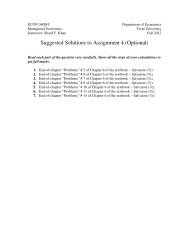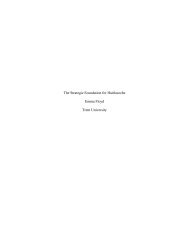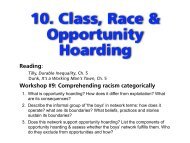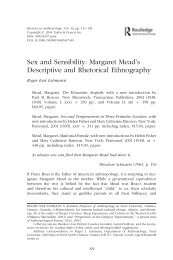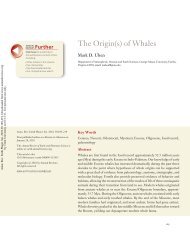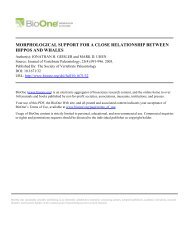REO FORTUNE'S PSYCHOLOGICAL THEORY OF CULTURAL ...
REO FORTUNE'S PSYCHOLOGICAL THEORY OF CULTURAL ...
REO FORTUNE'S PSYCHOLOGICAL THEORY OF CULTURAL ...
Create successful ePaper yourself
Turn your PDF publications into a flip-book with our unique Google optimized e-Paper software.
292 Pacifi c Studies, Vol. 32, Nos. 2/3—June/Sept. 2009<br />
It would not do to stir up fights within one’s own group. Moreover, to force<br />
a foreign woman to enter her husband’s group as a bride would be, in<br />
Arapesh belief, to court her husband’s death by sorcery. While Fortune<br />
depicted Arapesh individuals as needing to confront their sometimes conflicting<br />
egocentric and sociocentric desires, he did not turn to Arapesh<br />
dreams as a window on this dynamic.<br />
In the same article, Fortune challenged Mead’s ([1935] 2001) generalizations<br />
that Arapesh are profoundly nonviolent, lack warfare, and select “a<br />
maternal temperament, placid and domestic in its implications, both for<br />
men and women” (Fortune 1939, 36). Fortune’s evidence is compelling,<br />
based on Arapesh narratives, transcribed and translated with great linguistic<br />
skill (Roscoe 2003).<br />
In his ethnographies, Fortune portrayed people as changeable individuals,<br />
working within their social systems to balance personal and collective<br />
goals, which are easily at odds.<br />
Fortune’s Resistance to Stereotyping<br />
Retrospectives on early work of the culture and personality school demonstrate<br />
that researchers’ personalities, concerns, and interpersonal relations<br />
shaped their personified depictions of societies (Dobrin and Bashkow<br />
n.d). Fortune’s early study of dreams reveals a distaste for stereotyping<br />
people and groups. His intellectual position was that individuals, embedded<br />
in dynamic social life, are comprised of multiple, changing attitudes that<br />
are shaped by an ongoing internal dialog. When awake, this internal dialog<br />
is based on logical connections and spatial contiguities, but when dreaming,<br />
the inner discourse is based on affective association, in which emotional<br />
connections have precedence. Fortune argued that an individual’s cultural<br />
repertoire exists in two forms that are dynamic and sometimes contradictory:<br />
(1) logical-waking, which is dominant and socially attuned, and (2)<br />
affective-dreaming, which is recessive and egocentrically attuned. While he<br />
did not make it his business as an ethnographer to trace out these processes<br />
in detail, it is possible that this sophisticated position mitigated against<br />
his adopting the stereotyping excesses that marred the early culture and<br />
personality school’s otherwise valuable achievements. Most particularly,<br />
Fortune’s temperament and intellectual position, and not merely his resentment<br />
as a spurned husband, led him to reject two of Margaret Mead’s<br />
formulations: her unpublished “squares” or fourfold personality typing<br />
(Banner 2003: 326–33; Sullivan 2004; Thomas 2009) and her generalized<br />
gender types in Sex and Temperament in Three Primitive Societies ([1935]<br />
2001).<br />
pacs-32-02-06.indd 292 9/7/2009 2:32:34 PM



